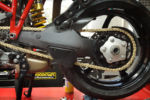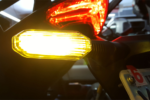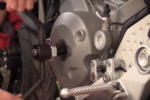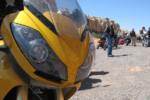Yeah, winter sucks. Mostly because the roads are covered with snow and Ice. It’s cold. Most of us are suffering with PMS (Parked Motorcycle Syndrome). So, what should we do to help our bikes deal with winter?
There still seems to be this idea that a great way to take care of your bike during those cold winter months is to head out into the garage, start the bike and let it warm up. This is actually one of the worst things you can do.
First, motorcycles don’t charge the battery while the engine is at idle. Second, unless you get the engine completely warm, what’s sometimes called “heat soak”, letting the engine idle, even for fifteen or twenty minutes will just build up more acids and condensation in the oil. It’s better to let sleeping dogs lie and allow your bike remain dormant for those few months.
However, there are a few things you can do to prepare your bike for that snowy hibernation.
Before parking the bike, we like to give the bike a nice, thorough wash and wax. If bugs are left on the paint for extended amounts of time, their acidic little carcasses could pit or damage the finish of whatever surface they are on. Plus, a clean and waxed bike will be resistant to accidental scuffs or scratches if something brushes past it.
If your bike is lucky enough to live in a garage, throw a clean sheet over your bike, and if your bike has to endure winter out of doors, get a nice quality bike cover to help prevent snow and ice from building up on the bike and to help keep the sun and UV from fading surfaces.
Gas
Dealing with the fuel is an important consideration, particularly if gasoline in your area is treated with Ethanol. Ethanol is toxic for your motorcycle. It’s bad enough when you are riding regularly, but it’s way worse when that evil corn gas is just sitting in your bike. If your bike has a plastic or composite tank, ethanol is known to cause them to swell and distort. Ethanol can also damage gaskets and fuel lines throughout the entire fuel system.
There are two thoughts on the best way to deal with this. One is to completely drain your entire fuel system and leave your gas cap cracked open to actually facilitate evaporation.
The second method, the one that most of us go with; If at all possible, fill your tank, all the way to the top with ethanol free gasoline. If you are unsure where to find ethanol-free fuel in your area check out pure-gas.org.
If you can’t find E0 in your area, you can put in some Ethanol treatment into your fuel. Our favorite is from Lucas oil, but Star Tron and Sta Bil both make a solid ethanol treatment product.
Depending on how long you expect your bike to sit, you may want to also add in some fuel stabilizer. But, honestly, if your bike is only going to sit for less than four months, a fuel stabilizer may not be necessary.
- Lucas Safeguard Ethanol Treatment
- Star Tron Ethanol Treatment
- Sta Bil Ethanol Treatment
- Sta Bil Fuel Stabilizer
- VP Fuel Utility Jug
- Trigger Spout/Hose
Oil
If you really want to go the extra mile, the last ride of the year is the perfect opportunity for an oil change. Part of what makes oil look dark and dirty is the result of combustion. The oil burns a little along the cylinder walls during combustion, and this is scraped off into the crankcase by the movement of the pistons. This burt oil, metal bits and combustion can be a little acidic. Flushing all those contaminants out with a fresh oil change just before you bike your bike for a few months is a great way to keep your engine healthy and happy. Plus, when it warms up again, you are ready to ride.
Battery
Your battery will need a little extra attention. A battery without a charge is more likely to freeze. Trickle chargers are popular. However, keeping a battery at full charge, called a full-saturation charge, will cause sulfation, which shortens the life of the battery. The best way to store a battery is to keep it above 2.05 volts and apply a topping charge every six months or so.
So, instead of using a simple trickle charger, we use the Optimate chargers, and instead of keeping the charger on the battery all winter, we move a single charger from bike to bike about once a week or so. If you only have one bike to deal with, just plug the charger it in for a few days about once a month, depending on how cold it is.
One cool side note about the Optimate, if you remove the battery from your bike, the Optimate will desulfate the battery by hitting it with big pulses of power. We’ve seen this process save batteries that we thought were no longer serviceable.
Tires
Tires sitting for a long while can develop flat spots. If you can get your bike up on a set of stands. What’s more, raw concrete can leech oils and whatnot out of your tire. So if your bike has to sit on bare concrete, throw a scrap of carpet or cardboard under the tire to create a little protective barrier. We typically put the bike on the centerstand or a rear stand, then, even though our floor is painted, throw a piece of cardboard under the front tire.
To the Shop
Winter is the perfect time for those bigger maintenance projects. Odds are, your local shop is a ghost town compared to its summer season. It is not uncommon for service rates to be lower to help bring in winter business, and in many cases, the technicians are not as rushed, meaning they will likely spend extra time on each job.
Now’s the time to get your forks serviced, your rear shock serviced, get those valves adjusted… You know, all those things you put off during the riding season.
In a lot of cases, you can bring down service costs even further by doing a lot of the prep work before bringing your bike in. Remove all your body panels and store them safely in your garage (or bedroom). Pull the forks or the rear shock and just bring those components to the service center.
In case of a collision, it is important to know what to do after a motorcycle accident. First Immediately after a motorcycle accident, make sure you are safe. Then you need to collect evidence and seek legal representation.
What’s more, tire prices usually go up in January. So once again, winter is a perfect time to shoe on some new sneakers. And when spring rolls around, you’ll have fresh sticky tires to deal with roads that may not be in the best of conditions after a long winter.






